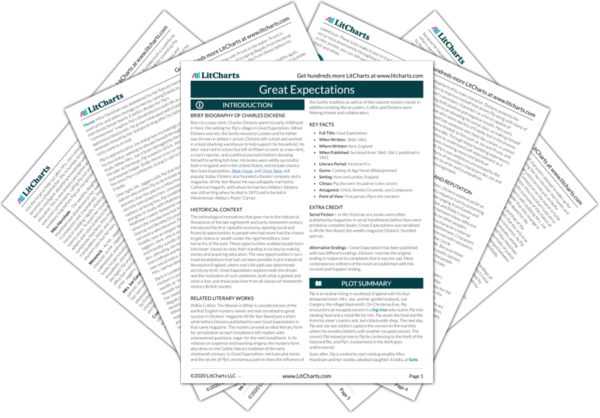Welcome to the LitCharts study guide on Charles Dickens's Great Expectations. Created by the original team behind SparkNotes, LitCharts are the world's best literature guides.
Great Expectations: Introduction
A concise biography of Charles Dickens plus historical and literary context for Great Expectations.
Great Expectations: Plot Summary
A quick-reference summary: Great Expectations on a single page.
Great Expectations: Detailed Summary & Analysis
In-depth summary and analysis of every chapter of Great Expectations. Visual theme-tracking, too.
Great Expectations: Themes
Explanations, analysis, and visualizations of Great Expectations's themes.
Great Expectations: Quotes
Great Expectations's important quotes, sortable by theme, character, or chapter.
Great Expectations: Characters
Description, analysis, and timelines for Great Expectations's characters.
Great Expectations: Symbols
Explanations of Great Expectations's symbols, and tracking of where they appear.
Great Expectations: Literary Devices
Great Expectations's key literary devices explained and sortable by chapter.
Great Expectations: Theme Wheel
An interactive data visualization of Great Expectations's plot and themes.
Brief Biography of Charles Dickens
Born to a navy clerk, Charles Dickens spent his early childhood in Kent, the setting for Pip's village in Great Expectations. When Dickens was ten, the family moved to London and his father was thrown in debtors' prison. Dickens left school and worked in a boot-blacking warehouse to help support his household. He later returned to school but left at fifteen to work as a law clerk, a court reporter, and a political journalist before devoting himself to writing full-time. His books were wildly successful both in England and in the United States, and include classics like Great Expectations, Bleak House, and Oliver Twist, still popular today. Dickens also founded a theater company and a magazine, All the Year Round. He was unhappily married to Catherine Hogarth, with whom he had ten children. Dickens was still writing when he died in 1870 and is buried in Westminster Abbey's Poets' Corner.
Get the entire Great Expectations LitChart as a printable PDF.

Historical Context of Great Expectations
The technological innovations that gave rise to the Industrial Revolution of the late eighteenth and early nineteenth century introduced the first capitalist economy, opening social and financial opportunities to people who had never had the chance to gain status or wealth under the rigid hereditary class hierarchy of the past. These opportunities enabled people born into lower classes to raise their standing in society by making money and acquiring education. The new opportunities in turn inspired ambitions that had not been possible in pre-Industrial Revolution England, where one's life path was determined strictly by birth. Great Expectations explores both the dream and the realization of such ambitions, both what is gained and what is lost, and showcases lives from all classes of nineteenth-century British society.
Other Books Related to Great Expectations
Wilkie Collins' The Woman in White is considered one of the earliest English mystery novels and was serialized to great success in Dickens' magazine All the Year Round just a short while before Dickens published his own Great Expectations in that same magazine. The mystery proved an ideal literary form for serialization as each installment left readers with unanswered questions, eager for the next installment. In its reliance on suspense and haunting enigma, the mystery form also drew on the Gothic literary tradition of the early nineteenth century. In Great Expectations, intricate plot twists and the secret of Pip's anonymous patron show the influence of the Gothic tradition as well as of the nascent mystery novel. In addition to being literary peers, Collins and Dickens were lifelong friends and collaborators.
Key Facts about Great Expectations
- Full Title: Great Expectations
- When Written: 1860-1861
- Where Written: Kent, England
- When Published: Serialized from 1860-1861; published in 1861
- Literary Period: Victorian Era
- Genre: Coming-of-Age Novel (Bildungsroman)
- Setting: Kent and London, England
- Climax: Pip discovers his patron is the convict
- Antagonist: Orlick, Bentley Drummle, and Compeyson
- Point of View: First person (Pip is the narrator)
Extra Credit for Great Expectations
Serial Fiction – In the Victorian era, books were often published by magazines in serial installments before they were printed as complete books. Great Expectations was serialized in All the Year Round, the weekly magazine Dickens' founded and ran.
Alternative Endings – Great Expectations has been published with two different endings. Dickens' rewrote the original ending in response to complaints that it was too sad. Most contemporary editions of the novel are published with this revised (and happier) ending.












